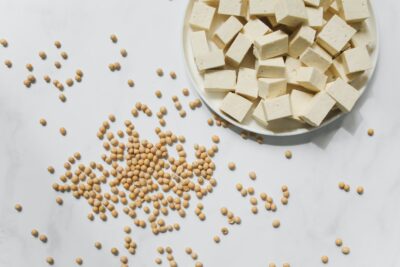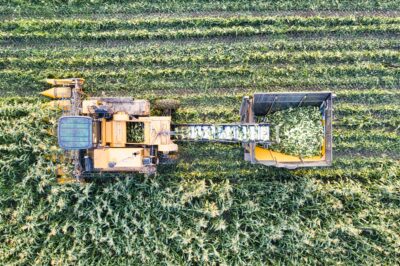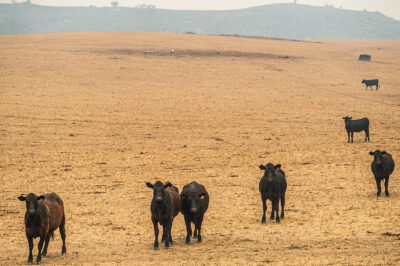Soya beans are delicious yet sneaky. They can be found in many places that you might not expect, whether that’s your favourite chocolate bar, baked goods, or even the fuel tank of your car. The production of soya has boomed over the last few decades, as the bean has grown in popularity not only in traditional forms such as tofu and edamame but also as an ingredient in less obvious products such as biodiesel. Yet despite the boom in soya production and its growing list of uses, the largest consumer of soya remains the same: animal agriculture. The vast majority of soya beans are grown to be fed to the animals trapped inside factory farms around the world. All that soya has to be grown somewhere, and unfortunately, cultivation of this versatile food helps drive deforestation in some of the most biodiverse places on the planet.
WHAT ARE SOYA BEANS?
Soya beans are one of the most prominent plant foods around the world. They play a key role in the nutrition of millions of people and can be found in a wide array of foods, processed and fresh. The plant was likely first domesticated in China, possibly as early as 7000 BC. Since then they have spread throughout the world and are now produced in huge quantities in the United States, Brazil, and Argentina.
WHAT ARE SOYA BEANS USED FOR?
Most of us are fans of soya beans in one form or another. We consume them as tofu or in processed foods. And because soya plays a key role in feeding many of the animals that are raised for meat, milk and eggs, a lot of people are reliant on it without realising. Many of us even use soya beans to fuel our cars.
FARMED ANIMAL FEED
Most of the protein in farmed animal feeds is derived from soya. Demand for soya has trended upward, with 77 per cent of soya produced worldwide going into farmed animal feed. Producing enough soya to meet demand has serious environmental implications. The production of soya beans has been the root cause of the destruction of more than 2.7 million hectares of forest in Argentina. Because forests store a large amount of carbon in the leaves and roots of trees, their destruction releases a large quantity of greenhouse gases.
HUMAN FOOD
Soya beans can be found in a variety of foods, ranging from those that are made almost exclusively out of soya to processed foods that aren’t likely to advertise their soya content to consumers.
- Soy sauce. Soy sauce is frequently used as a flavouring ingredient for a variety of east Asian dishes, though it originated in China. The ingredients in soy sauce are fairly basic and there are four key components: soy, salt, wheat, and water.
- Meat. Soya protein is used in the processing of many meat products. Soya is specifically used to increase the protein content, add flavouring, make processed meats a more desirable consistency, and capture any excess oil or water.
- Tofu. Tofu is a staple for many people, whether their diets are vegan, vegetarian, or omnivorous. Made out of only three ingredients — soya beans, water, and a coagulant — tofu is such a popular food thanks to its versatile nature. There are tofu recipes for everything from traditional steamed tofu to vegan BBQ ribs!
- Edamame beans. Edamame beans are immature soya beans that are often enjoyed in salads or steamed and eaten directly out of their shells with a bit of salt. Like mature soya beans, edamame beans are a decent source of vegan protein with 17g in one cup.
- Chocolate and other sweets. Soya beans, or more specifically soya lecithin, a fat byproduct from the soya oil production process, can be found on the ingredients lists of many of our favourite chocolate and baked goods. The ingredient is useful because it acts as an emulsifier, helping to combine oil and water, and as a surfactant, allowing you to mix liquids into dry ingredients more smoothly.
- Some beverages and whipped toppings. Soya beans can be soaked and turned into soya milk. Soya milk can also be made into whipped topping easily at home.
NON-FOOD USES
- Industrial uses. Over the last several decades soya beans have been increasingly used in a range of non-food, industrial items, often replacing petrochemicals. Among these uses are the production of rubber, plastics, adhesives, and lubricants. Part of the appeal of using soya beans as an ingredient stems from the fact that soya beans can be grown in a single year, whereas alternative ingredients are often not renewable.
- Biodiesel. Soya oil is often a key ingredient in biodiesel, which is usually formed via a reaction between a vegetable oil (or animal fat) and ethanol or methanol.
WHAT IS MOST SOYA USED FOR?
The vast majority of soya, a whopping 77 per cent, is used for feeding farmed animals, most of whom are trapped inside factory farms around the world. Of this, about 37 per cent is fed to chickens, 20.2 per cent is fed to pigs, and 5.6 per cent is used to feed farmed fish, with the remainder being fed to other species. Direct human consumption in the form of oil, tofu, tempeh, or other soya products accounts for 20 per cent of soya use. Industry uses, for example biodiesel and lubricant, account for the remaining roughly four per cent of soya.
WHICH COUNTRIES PRODUCE THE MOST SOYA?
From its original domestication in China more than 9000 years ago, soya has increased exponentially in both popularity and in its uses, and has seen a recent surge in production.
SOYA BEAN WORLD PRODUCTION
After reaching a peak of 359.5 million tonnes in 2017, soya bean production fell briefly before the pandemic to just over 336 million tonnes, and in 2020 had rebounded to 353.4 million tonnes. Despite the minor drop in production, the amount of soya produced in 2020 still represents a massive increase over what was being produced just ten years prior.
SOYA BEAN PRODUCTION BY COUNTRY
Though soya beans are used in products and as a primary component for feed in animal agriculture all over the world, there are a few countries that produce most of the global crop. The resulting soya beans are then packaged and exported internationally. The countries that produce the most soya are Brazil and the United States. In 2020, Brazil produced more than 121 million tonnes of soya beans and the United States produced just over 112 million tonnes. Individually, these countries each account for about a third of all soya bean production globally. Other countries that also produce a large amount of soya beans include Argentina (48.8 million tonnes), China (19.6 million tonnes), and Paraguay (11.02 million tonnes). Soya is not heavily planted in most of western Europe with Italy producing the most at just over 1 million tonnes in 2020.
Due to the climate the UK is not well suited to growing soya, instead it is imported. Roughly 3.2m tonnes of soya beans, meal, and oil are imported annually. Most of this, 68 per cent, is purchased directly from various countries in South America, with the remaining parts being sourced from the United States or acquired indirectly through the Netherlands. Efforts are being made to ensure that the soya beans that are being imported are not contributing to illegal deforestation and forest conversion. Yet it has been estimated that as of 2019, only 27 per cent of the soya imported into the country was covered by such a standard.
IS SOYA PRODUCTION DRIVING DEFORESTATION?
The largest driver of deforestation in the Amazon is cattle ranching for beef, but soya also has a detrimental effect. Much of the land that is being converted into soya fields comes from pastures that once supported farmed animals. Once the cows have eaten all the vegetation, they are moved on to degrade newly deforested lands and the soya farmers move in.
CONCLUSION
Whether you know it or not, soya likely plays a significant role in your consumption. Everything from our favourite snack foods to the fuel that powers our cars can contain soya, and this is especially true if we eat meat, fish, milk, or eggs. Unfortunately, this massive demand for soya has indirectly resulted in the expansion of deforestation. Choosing to eat vegan is a great way to limit the impact our diets have on tropical forests and the environment worldwide. Our consumer choices can help to end the expansion of cow grazing and the need for soya to feed farmed animals.





